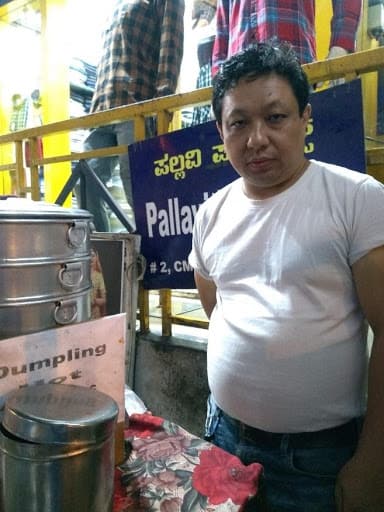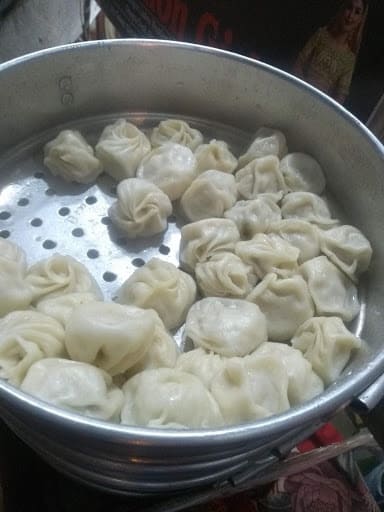Walking up CMH road, Indira Nagar, it is easy to miss the tiny momo outlets tucked away from the main road. Often made up of just a foldable table and a steaming vessel, these local haunts offer respite from cold evenings, hunger and a stressful day. Here, momos are served hot from the steaming vessel, accompanied by the trademark red chilli sauce.
One of these stalls is run by the sharp, friendly Shubas. In a conversation, Shubas revealed that he was from Darjeeling. He had moved to Bengaluru with his brother in 1991, in search of work. After a series of odd jobs, he opened his momo stall along CMH Road in 2005. His location has remained unchanged for 15 years.

He runs the business with the help of his brother, who makes the momos during the day. Shubas sells these momos in the evening, from around 5 till 8.30 or 9. “There is no wastage,” he says, “All the momos are sold out”. The momos are reasonably priced – veg momos at Rs 50 a plate, and chicken momos at Rs 60 a plate. The chicken momos are more popular, says Shubas.
Outsider/insider?
A large proportion of the city’s small momo outlets are run by those hailing from Northeastern states. Throughout our conversation, Subhas kept emphasising that he was Indian. He told me that most momo sellers in the city were from the Northeast and not Nepal. Clearly, he did not want to be mistaken for a Nepali. Referring to many people from the Northeast selling momos in Bengaluru, he emphasised, “Poorah India yahaan hai” (All of India is here).
That Shubas thought he needed to prove his Indian-ness to me, a complete stranger, was worrying, and spoke volumes on the discrimination many like him face from the “mainlanders”. However, not all momo sellers perceived such exclusion. Most had little trouble in the city when it came to people. “Of course,” says Rohini, another stall owner, “There are always issues with the police. Every now and then a Rs 1000 hafta (protection money) needs to be paid.”
Rohini has a husband and child back home, as well as aging parents she has to provide for. “Paisa thoda tight ho gaya,” she explains her reason for coming to Bengaluru. She had set up her stall in 2013, and sells bread omelettes apart from momos.
Momo prices doubled in 15 years, so has competition
Shubas says the demand for his momos has been nearly the same since 2005, indicating this dish has been a favourite among Bengalureans for long. Only, now there are a lot more outlets, and hence more competition for early birds like him. Just within a 600 m radius of his stall are two other stalls, both set up 5-6 years ago.

Momo prices have doubled since Shubas got here. In 2005, he used to charge just Rs 25 for a plate of veg momos and Rs 30 for a plate of chicken momos. However, competition has led him to increase the portion size – from six pieces per plate in 2005, to eight pieces today.
Is it lucrative to run a momo stall?
In a conversation with Dike, another momo seller, I was able to get a rough idea of whether this business was lucrative enough.
Following were the daily expenses of running a momo stall pre-COVID (there have been major fluctuations in the business since COVID):
| Ingredients | Cost (Rs/kg) | Quantity used (Kg) | Final Cost (Rs) |
|---|---|---|---|
| Maida | 90 | 3 | 180 |
| Onion | 120 | 5 | 600 |
| Chicken (Boneless) | 230 | 2 | 460 |
| Cabbage | 50 | 2 | 100 |
| Oil | |||
| For the chilli sauce: Tomato | 24 | 2 | 48 |
| Chilli | 200 | 0.5 | 100 |
| Garlic | |||
| White teel | 1 packet | ||
| ~ 1500 |
And below is Dike’s average earnings per month, after deducting her living expenses, house rent, etc.
| Number of momo plates sold | ~ 35 |
| Price per plate | ~ Rs 60 |
| Daily Revenue | Rs 2000 – 2100 |
| Daily Expenses | ~ Rs 1500 |
| Daily Profit | Rs 500 – 600 |
| Monthly Profit | Rs 15,000 – 18,000 |
| Rent | Rs 7000 |
| Electricity and Water | ~ Rs 1000 |
| Living/Other Expenses | ~ Rs 1000 |
| Final earnings per month | Rs 6000 – 9000 |
From the Rs 6000-9000 she eventually makes in a month, Dike has to send money back home for her child as well as for her own and her husband’s families. With ageing parents who can’t work, her expenses are only set to increase. Sometimes she’s unable to meet her child’s expenses.
With COVID, life has come difficult for Dike, as is the case with vendors across Bengaluru. During lockdown, she stayed put in the city. She and her husband lived off their savings while her sister covered the rent. Since her family back home received government rations, they had no significant expenses.

Post lockdown, she had resumed business around the second week of June. The price of chicken had gone up then, and so did her daily costs. This, along with the drop in customer numbers steeply reduced her daily profits. She now opens her stall at 3.30 in the afternoon to make up for lost sales, and hopes that business will be back to normal soon.
When I asked her what the future holds, Dike smiles and says she doesn’t know. For people living paycheck to paycheck, it is sometimes dangerous to dream.
[Note: This report was first written pre-COVID and updated based on more recent conversations. The figures and experiences represented may vary in present times.]
Momos are doing for the North-East what dosas and idlies did for the South – integrating with the rest of the country. Lovely article, well written.